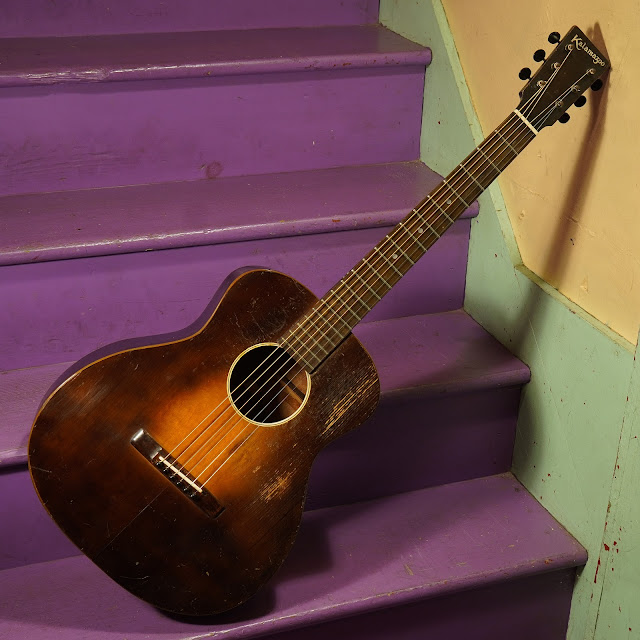1933 Gibson-made Kalamazoo KG-11 Flattop Guitar
Above: new video from 2023
Above: old video from 2019
Update 2023: the owner of this guitar is downsizing and so it's in here for resale. I've updated the photos, description, and specs where needed. It basically arrived back just as it left -- same action and playability, yip! -- but I did need to cleat the center seam on the top as it had dried-out enough to open up slightly. Now back to the description...
This is the earliest KG-11 I've worked-on so far. I've never seen another one quite like it. It looks like your average '33 but it has a tobacco-brownburst finish rather than a "small sunburst" with black edges. The bridge is finished in natural rather than painted black like other '33/'34 models and it has the rounded-around edges like on an L-00 or the like. The bracing is a little lighter, the neck is a thinner C-shape rather than V, and the fretboard is flat rather than radiused and made from ebonized maple instead of rosewood. It's like a late-'20s cheaper Gibson flattop met a KG-11 in the middle somewhere. It also has some cool, pearloid binding on the body reminiscent of the stuff used on some of the company's banjos at the time.
It also has the slightly-dodgy "no uppper-bout-brace" design with a wedge-shaped neckblock that runs all the way out to the end of the fretboard extension. It's not a bad idea in itself (it removes an extra step in building), but eliminating the crossing-brace right near the neckblock meant that the obvious happened as it took abuse -- the neck caved into the top a little bit -- causing hairline cracks at the side of the fretboard and a shift of the whole block and neck about 1/16" forward. I solved this while I was resetting the neck by hacking-away at the top of the neckblock with my Foredom (don't peek, it's not so pretty working upside-down and backwards on endgrain) and then making a heavy-duty rosewood brace/wing extension that wrapped around the block and serves to basically "extend" it outwards to hold the top together. It's held-up spot-on since being installed back in 2019.
After work, this thing plays and sounds nice. It has a woody, mellow quality to it that makes it a little more fun to just sit around with and play. It's not quite as "ballsy" as later KG-11s, but the sweet tone is easier on many folks' ears. I think fingerpickers will adore it.
Work included: a neck reset, fret seating (a lot of it) and level/dress, side dots install, saddle-slot fill (with rosewood) and recut (it wasn't compensated to begin-with), new bone saddle, minor seam and brace repairs, neckblock/neck joint reinforcement, a new bone nut, minor cleaning, and a setup. The neck is almost straight tuned to pitch (it deflects just a hair), but action is bang-on at 3/32" EA and 1/16" DGBE at the 12th fret, strung with 52w-11 gauges.
Scale length: 24 13/16"
Nut width: 1 3/4"
String spacing at nut: 1 7/16"
String spacing at bridge: 2 3/8"
Body length: 17 3/8"
Lower bout width: 14 5/8"
Waist width: 8 3/4"
Upper bout width: 10"
Side depth at endpin: 4 1/8"
Top wood: solid spruce
Back/sides wood: solid mahogany
Neck wood: mahogany
Bracing type: ladder
Fretboard: Brazilian rosewood, bone nut
Bridge: rosewood, bone saddle
Neck feel: medium C-shape, flat board
Weight: 3 lbs 0 oz
Condition notes: modified neckblock area, new saddle and nut, new ebony bridge pins, plenty of medium wear-and-tear to the finish and some "washboarding" on the upper bout from pickwear, some not-quite-perfect old seam repairs and brace repairs (not mine), and visual wear to the maple fretboard. There are a couple of tight (repaired) hairline cracks near the fretboard extension, one long hairline crack (repaired) on the back, and a freshly-cleated center seam separation on the top below the bridge.
It comes with: a good hard case.


























Comments